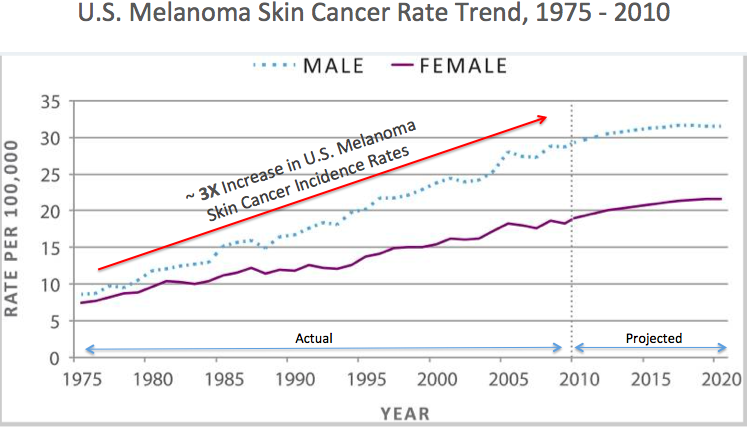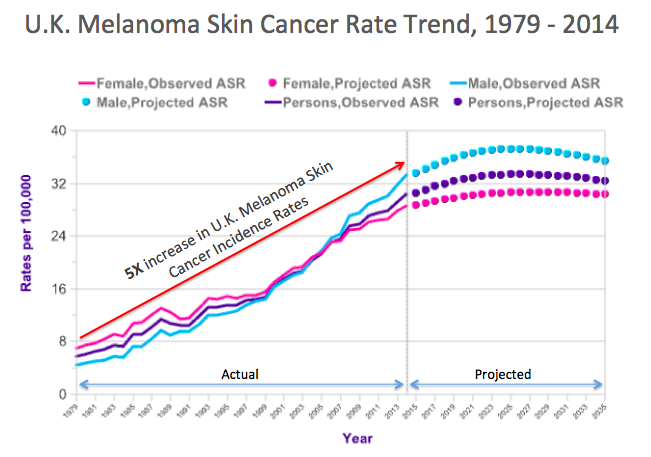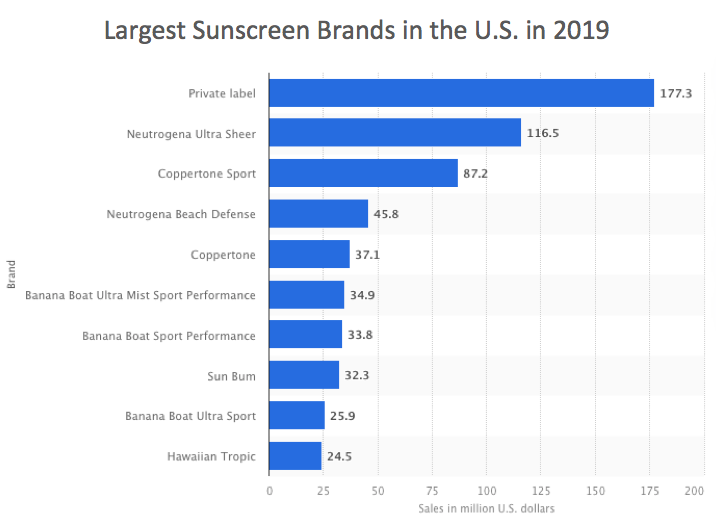Why Have Chemical Sunscreens Failed to Reduce Skin Cancer Rates?
Written by Ajay Chohan, Founder
Why have the biggest chemical sunscreen brands - Banana Boat, Coppertone and Neutrogena - not been able to help reduce skin cancer rates?
Everyone from the FDA to the CDC has emphasized for decades the important role sunscreen plays in helping prevent skin cancer. We are encouraged to apply and reapply generous amounts of sunscreen while out in the sun. It is then valid for us to ask if sunscreens have achieved what they promised, i.e. helping protect us from skin cancer. Unfortunately, data shows the opposite. Skin cancer rates have steadily increased since the 1970’s; the time from which we have a lot of the historical data available on skin cancer incidence rates. Noteworthy, sunscreens also started becoming popular and mainstream in the 1970s.
Now, what type of sunscreens have most Americans and the rest of the world been using these past several decades? The answer is overwhelmingly the chemical sunscreen brands Banana Boat, Coppertone and Neutrogena - as they dominate market share. Thus we can get more specific than just saying “sunscreens have not been able to reduce skin cancer rates,” and instead say, “the Banana Boat, Coppertone and Neutrogena sunscreens have failed to help reduce skin cancer rates.”
Skin Cancer Rates Have Steadily Increased Since the 1970s Despite Sunscreen Awareness
As sunscreens became mainstream and more & more people started applying them in the mid-20th century, a steady increase in skin cancer rates is not what we expected as a result. Certainly, sunscreen is only one part of safe sun habits, and we realize there are other factors at play. But Americans and the rest of the world applying chemical sunscreens has been the one key change in human behavior as skin cancer rates have risen over the past half a century. How much have skin cancer rates risen since the 1970s?
Let’s start by looking at the ‘U.S. Age-Adjusted Melanoma Skin Cancer Incidence Rates’ chart below from the National Library of Medicine. We see that the melanoma skin cancer incidence rates went from 7.5 cases per 100,000 women in 1975 to 18.5 cases per 100,000 women in 2010 (1). For men melanoma skin cancer incidence rates jumped from about 8.5 cases per 100,000 men to about 29 cases per 100,000 men in the same time period (1).
That’s an increase of about 2.5X or 147% for American women and 3.5X or 241% for American men in melanoma skin cancer incidence rates from 1975 to 2010, or an overall increase of around 3X. All the while the awareness around the importance of using sunscreens was increasing and sales of chemical sunscreen manufacturers skyrocketing.
Source: National Cancer Institute and the National Library of Medicine (1)
Now melanoma is the most serious but thankfully the rarest form of skin cancer. So the above growth rates and the number of cases per 100,000 do not reflect the total skin cancer cases, as they are not including the non-melanoma skin cancers (NMSC) which are Basal Cell Carcinoma (BCC) and Squamous Cell Carcinoma (SCC). BCC and SCC skin cancers are more prevalent and their growth rates have been going up as well. Per the American Academy of Dermatology Association, “it is estimated that the overall incidence of BCC increased by 145% between 1976-1984 and 2000-2010, and the overall incidence of SCC increased 263% over that same period. Women had a greater increase in incidence than men for both types of NMSC” (2).
Our second chart below, which is equally illuminating, is the ‘U.K. Age-Standardized Melanoma Skin Cancer Incidence Rates.’ This chart gives actual data from 1979 - 2014, then provides projections till 2035. I am focusing on the actual historical data here. We see that the increase in U.K.’s skin cancer rates has been even higher. The overall incidence rate went from about 6 cases per 100,000 in 1979 to 30 cases per 100,000 in 2014 (3). That’s an increase of 5X or 400% from 1979 - 2014 in U.K.’s melanoma skin cancer cases! That’s an obnoxious rise especially considering the booming chemical sunscreen sales during the period and the increased awareness around using such sunscreens.
Source: Cancer Research UK (3)
Why Have the Major Chemical Sunscreen Brands Failed to Reduce Skin Cancer Rates?
Sunscreens and sun tan oils started becoming more widespread in the 1970s and 80s, and skin cancer rates have been steadily increasing since then as well. As mentioned above, us asking whether sunscreens have helped reduce skin cancer rates is similar to asking if Neutrogena, Coppertone and the Banana Boat sunscreens have helped reduce skin cancer rates. This is because these 3 brands dominate market share in the U.S. and the globe. For some visual, below is a chart that show sales in the U.S. in 2019 of the leading sunscreen brands.
Source: Statista.com
A quick note on reading the bar chart above. The top row we see labeled ‘Private Label’ denotes thousands of smaller brands that get private labeling from a sunscreen manufacturer. Example, I can go to a manufacturer of sunscreens and say I want to private label their generic SPF 50 sunscreen and start selling it as “Ajay’s SPF 50 Sunscreen.” My sales would become part of the overall ‘Private Label’ market. So ‘Private Label’ denotes sales of all these smaller brands put together.
In terms of the largest individual sunscreen brands in the U.S., and probably globally, the ‘big 3’ are Neutrogena, Coppertone and Banana Boat. As they would one day hopefully say, the buck for ‘sunscreens helping prevent skin cancer starts and stops with us.’ We can hope. Hence when asking whether sunscreens help prevent skin cancer OR if they have historically reduced skin cancer rates, we can get more specific and ask how the big 3 chemical sunscreen brands - Neutrogena, Coppertone and Banana Boat - have performed. And the historical data clearly tells us that these three sunscreen brands have failed to help prevent and reduce skin cancer rates.
Diving Deeper into Skin Cancer and Toxic Chemical Sunscreens.
One hint behind the failure comes from the toxicity of the sunscreen ingredients themselves. Medical intuitive and author of the book Heal Yourself with Sunlight Andreas Moritz explained it quite well in this interview in 2009, where he says in regards to the carcinogenic chemicals in sunscreens “you absorb most of that stuff, these chemicals are highly absorbable, they enter the bloodstream, they go to the liver and then the liver has to break them down but that overtaxes the liver…and some of them accumulate in the connective tissues, and if they happen to be under the skin, they saturate there and you may develop skin cancer because you took the sunscreens, so sunscreens are now a leading cause of skin cancer.”
Now, whether they are a leading cause of skin cancer or not, the sheer toxicity of the ingredients certainly makes it plausible that some of the rise in skin cancer cases over the decades can actually be attributed to chemical sunscreens like Banana Boat, Coppertone or Neutrogena. The toxicity of chemical sunscreens given their ingredient profile is not an opinion. There have been tens of research studies documenting the individual ingredients’ toxicity. Which leads us to the below.
Toxic Sunscreen Chemicals & Contaminants Constantly Tied to Hormonal & Endocrine Disruptions, Lower Testosterone Levels, Allergic Reactions as well as Cancer Provide Some Cues on Chemical Sunscreens’ Impact on Human Health.
Let’s start by saying that there is a lot in chemical sunscreens that our body is not fond of. That is manifested both in immediate reactions such as itching or hives and the more concerning long term consequences such as endocrine disruptions, lower testosterone levels and cancer which are not immediately obvious. The immediate adverse reactions do tell us our body is rejecting this stuff.
Let’s dive into the specific ingredients commonly found across chemical sunscreens most popular in drugstores - Banana Boat, Coppertone and Neutrogena. Starting with Oxybenzone, this nasty chemical has been tied with everything from allergic skin reactions, endocrine disruptions, lower testosterone levels in boys and an increased risk of breast cancer (4). The second commonly found petrochemical in sunscreens is Avobenzone. This active ingredient along with Octocrylene, Oxybenzone and Octinoxate are part of Hawai’i’s banned list given the damage they are doing to coral reefs. So, these ingredients are deemed too toxic for our water bodies and coral reefs, but supposedly are safe to be continually applied and absorbed by our skins? In addition to environmental harm, Avobenzone can also trigger allergic skin reactions and again disrupt our endocrine function (4).
Yet another ingredient easily absorbed by our skin and into our bloodstreams that’s commonly found in drugstore chemical sunscreens is Homosalate. In studies, Homosalate was also shown to be an endocrine and hormonal disruptor. Lastly, Octisalate is an active ingredient to avoid especially if you have sensitive skin or eczema. This is because Octisalate has been repeatedly tied to allergic contact dermatitis and itchy skin rashes (5).
Octocrylene in Chemical Sunscreens - Most Closely Tied to Cancer Risk
In 2021, the independent lab Valisure detected high levels of the cancer causing carcinogen Benzene in several sunscreen brands. Neutrogena and Banana Boat sunscreens dominated that list, with many sunscreens from CVS Health, Sun Bum and others also in there, you can see the full list here. Some batches detected “up to three times the conditionally restricted FDA concentration limit [of Benzene] of 2 parts per million (ppm) (6).” Benzene is highly toxic and there is NO safe or acceptable level of Benzene in products.
Benzene has especially been tied to blood cancers like Leukemia. As the Valisure article further states, “The toxicity of Benzene in humans has been well established for over 120 years…A study from 1939 on Benzene stated that “exposure over a long period of time to any concentration of Benzene greater than zero is not safe” (6). All of this is especially concerning as according to the FDA the active ingredients in chemical sunscreens are easily absorbed by our skin, where they make their way into our bloodstreams and can stay for an extended period of time (7).
Now, what’s the link between cancer and Octocrylene? It has been suggested that the Octocrylene in sunscreens can be contaminated with Benzene. Also, the Consumer Product Testing Company has stated, “It has been strongly suggested that both Benzene and Benzophenone may form as a result of the degradation of Octocrylene within sunscreen product formulations” (8). SO, the Benzene that is being detected in chemical sunscreens could be due to Octocrylene’s degradation OR Octocrylene being contaminated with Benzene OR one of the many other complex synthetic ingredients in chemical sunscreens being contaminated with Benzene.
As stated above, Octocrylene has also been banned in Hawaii given the damage it was doing to coral tissues and coral reefs (9). If Octocrylene is considered too toxic for oceans and aquatic life, it probably is not much better for humans, and should absolutely not be in sunscreens. Lastly, Octocrylene has also been associated with high rates of skin allergies, another indication that our body and skin rejects this compound (4).
The Data Says…Chemical Sunscreens are Toxic and Do Not Help Prevent Skin Cancer.
Whether or not sunscreens are now a leading cause of skin cancer, as Andreas Moritz believes above, it is abundantly clear that chemical sunscreens that use the aforementioned ingredients are not safe for humans or the environment. And the data overwhelmingly supports that they have not helped to reduce skin cancer rates, quite the opposite. So, why exactly are we using them again?
As aforementioned, there have been research studies conducted on all the toxic sunscreen ingredients referenced above that mention health concerns and outcomes such as hormone disruptions, cancer, allergic skin reactions etc. They are not conjecture. The ingredients covered above — Oxybenzone, Avobenzone, Octocrylene, Homosalate, Octisalate — are commonly found across the board in chemical sunscreens. This of course includes the Banana Boat, Coppertone and Neutrogena sunscreens.
Note that I have individually covered all the health and environment concerns associated with the Banana Boat, Coppertone and Nuetrogena sunscreens in my research articles here, here and here. Feel free to check them out for a deeper dive into the specific brands.
Other Factors Also Likely at Play.
Now, chemical sunscreens with toxic ingredients are probably not the only cause for rising skin cancer rates. Indoor tanning is likely another culprit. Indoor tanning beds started becoming popular in the late 1970s, along with suntan lotion and sprays, and attribute some of the rise in skin cancer cases. But it’s important to keep in mind that the number of people visiting indoor tanning beds is a lot smaller than the number of people regularly applying chemical sunscreens on their face and bodies. And again, when I say Americans (and the rest of the world for that matter) applying sunscreens, that’s similar to saying people applying Banana Boat, Coppertone and Neutrogena sunscreens, given that these brands dominate market share. So the fact remains, that despite people being educated on the importance of applying sunscreens and increasingly applying these chemical sunscreens…skin cancer rates have not only not gone down or even stabilized…but have continued to rise.
And given the demographic trends in the U.S., Americans’ skin tones have gotten more diverse, darker and pigmented over the decades. So that trend should actually support a lowering of skin cancer cases, in addition to ‘awareness on the importance of lathering sunscreens.’ But despite the overall demographic trends, skin cancer rates have continued to climb.
Forming a Better Relationship with the Sun.
Let’s get to solutions! We know that getting sunshine is essential and good for us. Vitamin D is necessary for us to function and the majority of us are deficient in it. The key for everyone is, especially if you have pale skin, is to try to get that sunshine during hours when the UV index is low. The UV index is low during the first 2-3 hours after sunrise and the last 2-3 hours before sunset. So let’s say the sunset time is 8pm, if you go get your sun at 6pm, the UV index generally will be very low at the time. The primary goal, regardless of time of day, is to avoid getting sunburnt.
The author Andreas Moritz whom I referenced above emphasizes that our skin can gradually build its ability to tan and not burn. So increase your sun tolerance gradually. Start by getting 2 minutes of sun daily if that’s all your skin can handle and work the time up. Once your skin begins reddening, seek shade. Sun exposure is actually associated with a decreased risk of melanomas. It is only if you get a sun burn from that sun exposure, that your risk of melanoma goes up significantly. Needless to say, please do your own research on this, but I believe Andreas Moritz’s work provides a good starting point.
Now, if you do need to be, or want to be, out in the sun all day long, it’s important to find a safe sunscreen — a non-toxic physical mineral based sunscreen. Which leads us to the below.
Finding a Non-Toxic, Safe and Effective Sunscreen:
There are 3 key attributes of a non-toxic yet effective sunscreen:
The first thing is to avoid the toxic active ingredients found in most chemical based sunscreens - you know, the ones that are easily absorbed via our skin into our bloodstreams and are also harmful to coral reefs. The ‘big 6’ sunscreen ingredients to avoid are Avobenzone, Oxybenzone, Octocrylene, Homosalate, Octisalate, and Octinoxate
Second the sunscreen needs to be effective in protecting us against sun’s UVA and UVB rays. Find a natural mineral based sunscreen that sits on top of the skin and is non-nano. Non-nano meaning it will not be absorbed by the skin. Look for a sunscreen with non-nano Zinc Oxide as the primary active ingredient
Now, besides doing the important work of protecting us against harmful UV rays, what if the sunscreen was actually nourishing for our skin? Find a sunscreen where ingredients are plant based and in their wholesome state
My best natural sunscreens article goes deeper into the attributes of a better sunscreen. I also give my natural mineral sunscreen recommendations there, so feel free to check it out.
Do you currently use one of the big brand chemical sunscreens? Have you already found a safe all-natural sunscreen you like? Share your thoughts below! Please also share the article if you believe a loved one can benefit from this important research! Signing off, Ajay.
Sources:
https://www.ncbi.nlm.nih.gov/books/NBK247164/figure/skincancer.f3/
https://www.aad.org/media/stats-skin-cancer
https://www.cancerresearchuk.org/health-professional/cancer-statistics/statistics-by-cancer-type/melanoma-skin-cancer/incidence#heading-Four
https://www.ewg.org/sunscreen/report/the-trouble-with-sunscreen-chemicals/
https://pubmed.ncbi.nlm.nih.gov/16956469/
https://www.valisure.com/valisure-newsroom/valisure-detects-benzene-in-sunscreen
https://www.fda.gov/news-events/fda-voices/shedding-more-light-sunscreen-absorption
https://cptclabs.com/benzene-benzophenone-in-sunscreen-products/
https://cen.acs.org/environment/water/Common-sunscreen-ingredient-octocrylene-might/97/web/2019/01




